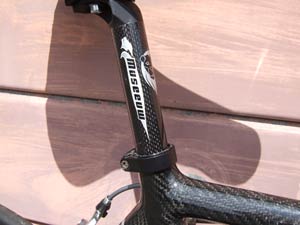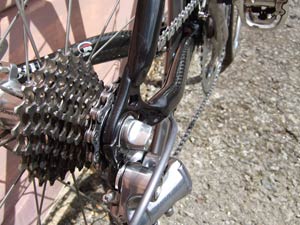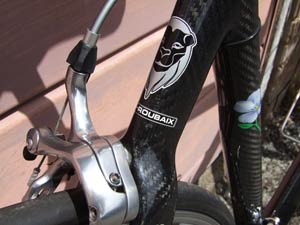 Pretty in pink |
 Flax flower decorates frame and fork |
Musseuw Bikes MF1 £2950 frame, fork, headset, seatpost
Even a year after first slinging a leg over it, this bike never fails to amaze me. Or, rather, carbon flax hybrid composites never fail to amaze me. In many respects the MF1 is no more nor less than you’d expect of a bike at its elevated price point; impressively light, exceptionally stiff nonetheless, beautifully finished (for the most part) and possessed of immaculate road manners. Close inspection confirms that it was built using the well-proven carbon wrap technique developed by leading Italian frame builders in the early Noughties. Roberto Billato, whose name appears on the frame as builder, and who now runs the Museeuw Bikes manufacturing operation, was chief amongst them and for several years used the method to build race-winning bikes for some top pros.
This early example, however, was built not by Billato, but by another less well-known small-scale factory near Padova, and although sturdy, curvaceous and delightful in many ways, it suffers one significant defect: the aluminium inserts that hold the steering bearings were poorly machined, leaving the integrated bearings free to slop around no matter how tightly nipped up. The only answer was to glue them in place with JB Weld epoxy, which did the trick but left the steering a little stiff and insensitive.
It is a measure of how good is the rest of the frame and fork assembly that this defect, serious in any bike, has not deterred me from riding it a lot. With the 2007 London Paris Cycle Tour, several time trials and a couple of sportives under its wheels, the Museeuw has also seen hundreds of miles of commuting action, on one occasion leading to the defining moment of my relationship with it.
 An early one… |
 Branded Museeuw carbon post is part of package |
Cut up slightly at Rosehill roundabout by a sap in a BMW M3 coupe, I chased hard on the long descent towards Sutton knowing that, if the lights at the Angel Hill cutting went my way, I would catch up coming into the town one-way system. So it proved and I caught up just as M3 man got caught up behind a bus. With nothing coming the other way, I hooned up the outside in 53×14 only to find M3 man making a right turn into a side street having neither looked nor indicated.
I hit his offside wing just aft of the wheel arch at at least 20mph square-on, clearing the bonnet and landing on my backside 10 feet further down the road. The Museeuw bounced backwards, rear wheel in the air and dropped onto its STI levers, leaving an identical indent in each. In the ensuing discussion it became clear that M3 man had simply decided to try a short cut at short notice. It cost him a meaty dent in his wing, but the damage to the MF1 was limited to those scuffs in the STI levers. The frame and fork were completely unharmed by a whack that would surely have folded any metal frame and shattered most composites ones.
Indeed, since that stack back in November, the bike has covered another 500 miles without attention. Impressive stuff, but how, why and what? The addition of flax fibres to carbon is, rightly, said to reduce vibration and road shock. This they apparently do thanks to some peculiarity of the flax version of cellulose, which is exceptionally strong and tough. The effect is perhaps best described as knocking the sharp edges off bumps, as if they were rounded like a cottage loaf instead of sharp-edged like a brick. So pronounced is the effect that, paradoxically, it goes unnoticed most of the time; occasionally, perhaps after scooting across a nasty section of broken Tarmac, I will remember with a start just how little harshness has been felt despite the incredible stiffness of the frame.
 Chainstays splay out too far |
 Roubaix colour scheme perhaps the nicest |
There is, however, something more. Flax is added by inserting a layer of woven flax cloth between the sheets of carbon twill prior to the compression and heating phase that both sets the resin matrix and squeezes out air pockets. The flax layer is quite thick for its weight, much like a linen tea towel, and my guess is that this creates a lightweight gap – filled, obviously, by flax fibres – between the thin inner and outer layers of carbon that form the wall of the tube.
Such a technique, widely used in lightweight structures for its exceptional strength to weight properties, may help to explain how the Museeuw manages to be so robust without carrying much weight…
There is, of course, no other way to get hold of this technology than to buy a Museeuw. This means opting for one of a range of colour schemes that, and this is obviously a subjective judgement, seems to lack a little something in comparison with the best from, for example, Italy. As it happens, the ‘Roubaix’ scheme seen here looks fine if a little sombre and was set off very nicely by the white finish of the DT Mon Chasseral wheels tested recently. There is also the matter of the chainstays, which bend outwards too far from the dropouts and clipped my heels occasionally despite the fact I do not ride notably heel-inward.
This may not be the case with newer examples, since not only has the shape of their tubes but the very method of construction changed recently. While the MF1 is still available to special order made using the carbon-wrap technique, almost all Museeuw frames are now built using lugged construction. The result is said to be even stiffer thanks to the sheer size of the external carbon lugs. Quite who would want a frame even stiffer than this MF1 is hard to imagine… unless the Lion of Flanders himself has just put in a special order.
Verdict
Unique technology confers unquestionable advantages
 Light, stiff, great finish, amazing ride
Light, stiff, great finish, amazing ride
 Some iffy colour schemes, dodgy headset (this frame)
Some iffy colour schemes, dodgy headset (this frame)







